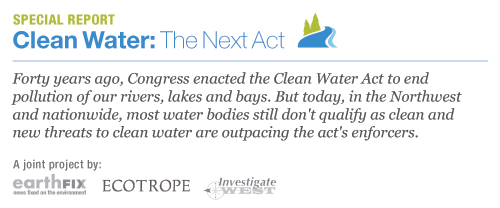A major goal of the 1972 Clean Water Act was to stop cities and towns from discharging raw sewage. The federal government gave communities billion of dollars to build wastewater treatment plants. But those early grants are gone and those plants have aged.
As part of our series on the 40th Anniversary of the Clean Water Act, Bonnie Stewart takes us first to a small town that is making the transition to leaner times thanks in part to a fire chief who doubles as the operator of a wastewater treatment plant. [SOQ 5:07]
[Host outro: We had help on this story from Courtney Flatt in Eastern Washington. For more in our EarthFix series on the Clean Water Act go to (your website).]
The Eastern Washington town of Harrington is surrounded by farmland. It’s home to four hundred and twenty people. In 2005, the city had to built a new wastewater treatment plant.
Mayor Paul Gilliland [Gill-EH-Land] climbs into a white pickup truck and takes us on a tour.
Gilliland: “You start here. Coming in from the city is the main sewer pipes that brings the 50,000 gallons a day from the city down into our diverter box to the swirl concentrators that pull out large chunks of mostly feminine disposable apparatus that you flush down the toilet without thinking.”
The city of Harrington is short-staffed. Fire chief Scott McGowan also has to manage the drinking water system and the wastewater treatment plant.
Gilliland: “He’s in charge of anything with the sewer system breaks in town he has to go fix it. He’s spread very, very thin.”
That’s why mayor Gilliland plans to become a certified wastewater operator, too. Then he can be a backup for the fire chief.
The new plant has not been trouble free. Breakdowns have led to violations and expenses. And of course, building the plant wasn’t cheap.
Gilliland: “The city still has, seven years after we built it, one and a half million dollars that it still owes and it’s been a burden.”
The plant has operating costs, too, driving the monthly sewer fee rate to sixty-five dollars per household. That’s twenty-dollars more than Seattle charges and five dollars more than Portland.
Having a fire chief operate a wastewater treatment plant may be unique to Harrington, but cities across the country are struggling to keep our waters clean.In the Pacific Northwest alone, there are 550 municipal wastewater plants. Many of them have fallen out of compliance.
In Eastern Oregon, the Confederated Tribes of Warm Springs has two wastewater treatment plants. Together they have violated their permits 99 times in the last three years.
Chae Park is with the U.S. Environmental Protection Agency. He says poor plant operation and maintenance led to the violations.
Records show that both plants have been exceeding their limits for total suspended solids and e-coli.
Park explains the dangers of these pollutants.
Park: “In terms of their effect on the environment, I think there is definitely potential for adverse effects. For example, suspended solids are going to affect the fish. It may clog their gills. And certainly e-coli, that’s a pathogen. That could come in contact with recreational users, swimmers for example. “
The two plants discharge into streams that provide spawning and rearing habitat for salmon, steelhead, trout and Pacific lamprey. People use those waters for kayaking, fishing and swimming.
Park says the Tribe has hired a new wastewater operator and more workers to help maintain the plants.
The Warm Springs Tribe did not respond to numerous requests for an interview.
Many sewage treatment plants in the Pacific Northwest violate their discharge permits every year, some multiple times. Washington cities racked up more than fifteen hundred violations in the past two years. Idaho’s cities tallied more than seventeen hundred in a three-year period. Comparable data are not readily available for Oregon.
Make no mistake; the Clean Water Act has stopped a lot of pollution. But some waterways still suffer from what cities discharge through their pipes.
The South Umpqua basin in southern Oregon is one of them. Its water quality ranges from poor to very poor.Jon Gasik is an environmental engineer with Oregon’s Department of Environmental Quality. He says several cities along that river are working to curb their pollution.
Gasik: “In the South Umpqua it will make a big difference. That’s one of the, probably one of the few streams left that the point sources are really impacting the water body.”
Roseburg is one of the cities there. It had to get creative to handle its discharges.
Gasik: “They were going to have to get to such low phosphorus levels, that they estimated it as a sixty to eighty-million dollar upgrade.”
Instead, Roseburg found a way to apply its treated wastewater to the land instead of sending it into the river.
For their part, bigger cities like Portland and Seattle have been overhauling their sewage systems so they won’t overflow during heavy rains. They’ve spent billions of dollars on upgrades.
No one really knows how much it would cost stop the pollution from sewage systems. A 2008 federal survey shows that it would take at least ten billion dollars to meet the wastewater treatment needs in Oregon, Washington and Idaho. But that figure doesn’t reflect the true price tag because many cities don’t respond to the survey. Another one is underway. But the results won’t be released until next year.
I’m Bonnie Stewart reporting.
